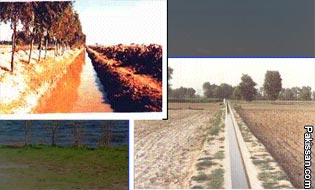|
Special
Reports/Water Crisis |
Saving irrigation water
By Bilal Hassan
ABOUT 22 per cent of the gross domestic product (GDP) comes
from the agriculture sector. Crops are cultivated in
irrigated as well as rain-fed areas. However, irrigated
farming is most important. Growth of agriculture, however,
depends upon environment.
 About
18.78 million hectares of total 22.94 million hectares
cropped area is irrigated. The main sources of irrigation
water are canals and underground water pumped through
tube-wells. The country is endowed with huge water resources
including precipitation (rainfall, dew, fog, hails etc.,),
surface water and ground water. About
18.78 million hectares of total 22.94 million hectares
cropped area is irrigated. The main sources of irrigation
water are canals and underground water pumped through
tube-wells. The country is endowed with huge water resources
including precipitation (rainfall, dew, fog, hails etc.,),
surface water and ground water.
The Indus Basin Irrigation system is the world’s largest
integrated irrigation network that comprises of three large
water reservoirs, 19 barrages, 12 inter-river link canals,
43 irrigation canals including perennial, annual, flood and
over 107,000 watercourses.
The total length of canals is around 61,000km whereas
watercourses and farm channels measures 1.6 million
kilometres. The system drains an average of 106 MAF of
surface water each year for irrigation purpose. It is
supplemented by 43 MAF ground water pumped by means of
tube-wells per annum.
Irrigation water is a key input for growth and development
of crops that contribute to value-added in agriculture and
the GDP, significantly. Regular supply of irrigation water
is essential to sustain crop productivity. In case, one or
two critical growth stages go without irrigation during the
lifecycle of a crop, it would result in significant
reduction in crop production. The adverse effects on per
hectare yield of crops in 2000-01, 2001-02 and 2003-04 was
due to unprecedented water shortage.
Irrigation efficiency of canal system is poor due to
considerable loss of water in the form of seepage,
percolation, and evaporation. About 35 per cent water is
lost through canals, 24 per cent though larger and smaller
distributaries and 25 per cent during field application.
As the agriculture is primarily dependent upon canal
irrigation system, maintaining and improving this system is,
therefore, crucial for sustainability of crop yield and
thereby agriculture. Crop productivity could be improved
either by enhancing per hectare yield or by increasing area
under arable crops. Water is essential in either case.
Water management and conservation practices should be given
top propriety. Crop management practices that are helpful
for saving water and improving water use efficiency at field
level include selection of suitable cultivar, timely sowing,
optimum plant population, recommended sowing method,
standard irrigation methods, application of fertilizers in
balanced amount, irrigation at right time, weed eradication
and adequate plant protection measures.
Fine seedbed preparation, levelling of field, deep
ploughing, and incorporation of farm yard manures and
commercial fertilizers and artificial or natural mulching
are soil management techniques that are helpful in
conserving water resources.
Lining of canals and watercourses with protected material
like cement is essential to plug seepage and percolation
losses but this practice is time consuming and costly.
However, a multiple approach viz., engineering cum
vegetative would be greatly helpful in curtailing the
problem of seepage, evaporation and percolation.
Defective water rotation programme, inefficient cropping
pattern, low cropping intensity, use of outdated irrigation
technology, and lack of investment for renovation of the
irrigation system are major impediments in conserving water
resources.
An acute shortage of irrigation water in certain parts of
Sindh has restricted the cotton sowing. The Irrigation
Department has resorted to the rotation programme due to low
level of water canals. After germination of cotton seed, the
first watering is required within seven days, but farmers
failed to irrigate them on time due to the rotation
programme and sprouted plants died. They cannot survive
without water when the temperature is also high.
The correct planting of crops and an efficient irrigation
system can reduce water use by 50 to 70 per cent and overall
water consumption by up to 25 per cent. Water specialists
were becoming more and more convinced that the country is at
present on the threshold of a serious water crisis. Water
shortage is not only observed in irrigation but also in
other uses and it was necessary to develop new water-saving
technologies. Conservation and development of natural water
asset is of utmost importance.
To prevent future shortage of water, it is imperative to
take all possible measures against degrading water
resources.
Again, there is a need to improve water rotation programme
to insure that crops get irrigation at the right time. It
happens that there is excessive availability of irrigation
water when crop doesn’t need it and the result is loss of
water. Growers are suggested to irrigate crops optimally
because over and under-irrigation is detrimental for crop
growth and development.
To cope with water shortage, complete reorganization of
water sector institutions through mergers, economic
utilization of water resources of the country, procurement
of additional storage for crops round the year, building
storage to overcome droughts and to develop comprehensive
water and hydro resource policy are necessary.
Courtesy :
The DAWN
|
Pakissan.com;
|